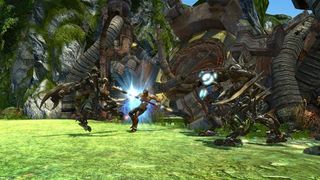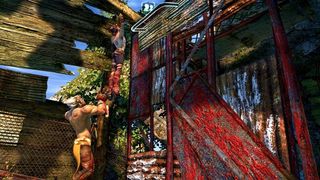We're frankly reeling in astonishment from our recent hands-on with Enslaved: Odyssey to the West. We saw the game a while back in a hands-off preview and we weren't sure what to think of this unusual game. It struck us as somewhat original in its portrayal of a post-apocalyptic New York as a lush, overgrown ghost town rather than the standard brown, dusty wasteland seen in almost all after-the-end-of-the-world games. Yet its gameplay and storytelling left us mostly with a question mark – the combat seemed standard fare, and all the claims of professional writing by 28 Days Later scribe Alex Garland were only talk with no real walk, thanks to unfinished voice-overs unable to convey anything other than weird, buggy computer-delivered dialogue.

Clearly that preview was not a case of Enslaved putting its best foot forward. And understand this: that preview was pretty good. What we've just finished playing has gotten us excited in a way we never saw coming. We're really hoping the final product doesn't make us look like we're overhyping things, because right now we think we've just tasted a true original, a game that takes videogame storytelling to a new level. It's possible some players won't see in Enslaved what we've seen, because the most exciting aspects of the game are in tiny details.
Take, for instance, the first time you see the kill-cam as your hero, Monkey, splits a mech in two with his staff. Words can't describe what it is that makes it special – it's like one of those tiny gem shots in a movie that completely makes a scene but you can't say why. Or how about the way that Trip, the vulnerable girl who has enslaved Monkey out of necessity rather than malice, has the most soulful eyes we've ever seen in a videogame character. Or maybe the fleeting glimpse of a deer bounding away out of Grand Central Station in Manhattan – the only evidence that anything bigger than a bird still lives in this far-off future.

This is truly a case of where playing a game, rather than watching it, makes all the difference. The moment we took control of Monkey, it hit us: this game is constructed with care and an energetic urge to push every aspect creatively. When you move the stick, Monkey darts, sprints, and shifts directions with agility and crispness that you can't see, but only feel. It's the same with his cloud – it's a holographic disc he can only deploy in certain places and he rides it like a hoverboard. It doesn't look particularly special, but when you control it, there's a cushiony, floaty sensation to it that really conveys the idea of riding a cloud.
The overall flow of gameplay is not combat-heavy; much of the game involves climbing and navigating obstacles, exploring ruins, and helping Trip get from place to place since she doesn't have the athleticism that Monkey has. Enemies are never just randomly sprinkled around the environment – every encounter feels designed and presents a unique challenge. The combat itself isn't God of War – the combos are simple – we haven't seen any air juggles or ten-hit flurries. You do get to earn upgrades to your abilities, but we didn't encounter tons of moves to unlock. Instead, combat encounters tend to be tactical: you command Trip to distract enemies with her holograms while you dart between cover and flank entrenched mechs. Monkey's staff also has limited ammo for ranged attacks, including the important stun shots which you'll need to overcome certain mechs' shields.

The bosses we've fought are Zelda-like in their puzzle-centric nature, although the puzzles are more about timing than figuring out some obscure way to vanquish the boss. An exciting one involves a massive arena for you to race around in on your cloud to gain distance from a thundering mech before pulling out your staff to fire a shot. It's like trying to shoot a charging elephant – you only have a few seconds and watching the galloping beast get closer and closer is a bit terrifying.
In fact, fear comes to the forefront of Enslaved in a way that most non-horror action games never bother with. Monkey is brave, but he never has that invincible swagger so many heroes thrust in our faces. More importantly, it's Trip and her eyes that let you know how big, empty and scary Enslaved's world is. The relationship between Trip and Monkey is layered and complex, and conveys how humanity, or what's left of it, is clinging desperately to survival. And then there is the mystery that hangs over everything – what were people fighting over before the apocalypse? Did the war cause it? Who are the slavers, and where do they take their slaves? Who is Monkey really? All of these questions push the desire to play forward – we really want to know the answers.

Enslaved has popped on our radar unexpectedly and with a quiet confidence that's reassuring – we'll be quite surprised if the complete, final product doesn't live up to the quality it has established in the early part of the game. It's possible the secrets, once revealed, will be disappointing, but unless the gameplay somehow falls apart as well, we're not too worried. What does worry us is that Enslaved could turn out to be the sleeper game of the season amongst critics, and yet get ignored by players. Will its target audience even be aware of it? Will they give it a chance after a surface glance that doesn't reveal the important details? Story-wise, it's now the most promising game of the next few months.
Sep 7, 2010

